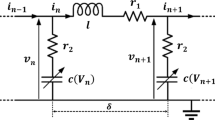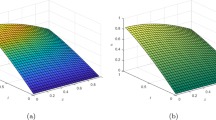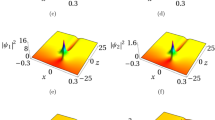Abstract
When comparing solutions for the propagation of SH waves in plane parallel layered elastic and viscoelastic (anelastic) media, one of the first things that becomes apparent is that in the elastic case the location of the saddle points required to obtain a high frequency approximation are located on the real p axis. This is true of the branch points also. In a viscoelastic medium this is not typical. The saddle point corresponding to an arrival lies in the first quadrant of the complex p-plane as do the branch points. Additionally, in the elastic case the saddle point and branch points lie on a straight line drawn through the origin (the positive real axis in the complex p-plane), while in the viscoelastic case this is generally not the case and the saddle point and branch points lie in such a manner as to indicate the degree of their complex values.
In this paper simple SH reflected and transmitted particle displacement arrivals due to a point torque source at the surface in a viscoelastic medium composed of a layer over a half space will be considered. The path of steepest descent defining the saddle point in the first quadrant will be parameterized in terms of a real variable and the high frequency solutions and intermediate analytic results obtained will be used to formulate more specific constraints and observations regarding saddle point location relative to branch point locations in the complex p-plane.
As saddle point determination for an arrival is, in general, the solution of a non-linear equation in two unknowns (the real and imaginary parts of the complex saddle point p 0), which must be solved numerically, the use of analytical methods for investigating this problem type is somewhat limited.
Numerical experimentation using well documented solution methods, such as Newton's method, was undertaken and some observations were made. Although fairly basic, they did provide for the design of algorithms for the computation of synthetic traces that displayed more efficient convergence and accuracy than those previously employed. This was the primary motivation for this work and the results from the SH problem may be used with minimal modifications to address the more complicated subject of coupled P-SV wave propagation in viscoelastic media.
Another reason for revisiting a problem that has received some attention in the literature was to approach it in a fairly comprehensive manner so that a number of specific observations may be made regarding the location of the saddle point in the complex p-plane and to incorporate these into computer software. These have been found to result in more efficient algorithms for the SH wave propagation and a significant enhancement of the comparable software in the P-SV problem.
Similar content being viewed by others
References
Abramowitz M. and Stegun I.A., 1980. Handbook of Mathematical Functions. Dover Pubns, New York, USA, 1046 pp.
Azimi Sh.A., Kalinin A.V., Kalinin V.V. and Pivovarov B.L., 1968. Impulse and transient characteristics of media with linear and quadratic absorption laws. Izv. Phys. Solid Earth, 2, 88-93.
Aki K. and Richards P.G., 1980. Quantitative Seismology. W.H. Freeman and Company, San Francisco, USA.
Borcherdt R.D., 1977. Reflection and refraction of type-II S-waves in elastic and anelastic media. Bull. Seismol. Soc. Amer., 67, 43-67.
Buchen P.W., 1971a. Plane waves in linear viscoelastic media. Geophys. J. Roy. astr. Soc., 23, 531-542.
Buchen P.W., 1971b. Reflection, transmission and diffraction of SH waves in linear viscoelastic solids. Geophys. J. Roy. astr. Soc., 25, 97-113.
Buchen P.W., 1974. Application of the ray-series method to linear viscoelastic wave propagation. Pure Appl. Geophys., 112, 1011-1029.
Červený V. and Ravindra R., 1971. Theory of Seismic Head Waves, University of Toronto Press, Toronto, Canada.
Futterman W.I., 1962. Dispersive body waves. J. Geophys. Res., 67, 5279-5291.
Hearn D.J. and Krebes E.S., 1990a. Complex rays applied to wave propagation in a viscoelastic medium. Pure Appl. Geophys., 132, 401-415.
Hearn D.J. and Krebes E.S., 1990b. On computing ray-synthetic seismograms for anelastic media using complex rays. Geophysics, 55, 422-432.
Johnston D.M. and Toksöz N.M (Eds.), 1981. Seismic Wave Attenuation. Geophysics reprint series, Society of Exploration Geophysicists, Tulsa, USA.
Krebes E.S., 1984. On the reflection and transmission of viscoelastic waves-some numerical results. Geophysics, 49, 1374-1380.
Krebes E.S. and Hron F., 1980a. Ray-synthetic seismograms for SH waves in anelastic media. Bull. Seismol. Soc. Amer., 70, 29-46.
Krebes E.S. and Hron F., 1980b. Synthetic seismograms for SH waves in layered anelastic media by asymptotic ray theory. Bull. Seismol. Soc. Amer., 70, 2005-2020.
Le L.H.T., Krebes E.S. and Quiroga-Goode G.E., 1994. Synthetic seismograms for SH waves in anelastic transversely isotropic media. Geophys. J. Int., 116, 598-604.
Lomnitz C., 1957. Linear dissipation in solids. J. Appl. Phys., 28, 201-205.
Marcuvitz N. and Felsen L.B., 1973. Radiation and Scattering of Waves, Prentice Hall, New Jersey, USA.
Mikhailenko B.G., 1985. Numerical experiment in seismic investigation. J. Geophys., 58, 101-124.
Press W.H., Teukolsky S.A., Vetterling W.T. and Flannery B.P., 1997. Numerical Recipes for Fortran 77, Press Syndicate, New York, USA.
Richards P.G., 1984. On wave fronts and interfaces in anelastic media. Bull. Seismol. Soc. Amer., 74, 2157-2165.
Zahradník J., Jech J. and Moczo P., 1990. Approximate absorption corrections for complete SH seismograms. Stud. Geophys. Geod., 34, 185-196.
Author information
Authors and Affiliations
Rights and permissions
About this article
Cite this article
Daley, P., Krebes, E. SH Wave Propagation in Viscoelastic Media. Studia Geophysica et Geodaetica 48, 563–587 (2004). https://doi.org/10.1023/B:SGEG.0000037472.40481.cd
Published:
Issue Date:
DOI: https://doi.org/10.1023/B:SGEG.0000037472.40481.cd




